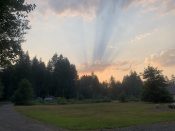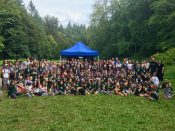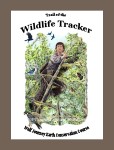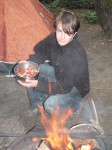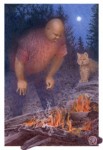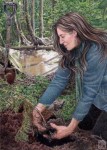 It’s been a long time coming. The great Haitian-American naturalist John James Audubon hand-painted The Birds of America between 1927-1939 and with it, he set the standard for modern field guides. Now there are several excellent field guides to the birds, but it has only been recently that field guides to plants and other animals have risen to that level of user-friendly excellence. The following is a list of my Top 10 wildlife tracking book compilations, with must-have field guides in bold:
It’s been a long time coming. The great Haitian-American naturalist John James Audubon hand-painted The Birds of America between 1927-1939 and with it, he set the standard for modern field guides. Now there are several excellent field guides to the birds, but it has only been recently that field guides to plants and other animals have risen to that level of user-friendly excellence. The following is a list of my Top 10 wildlife tracking book compilations, with must-have field guides in bold:
1948 Ellsworth Jaeger: Tracks and Trailcraft by Ellsworth Jaeger, first published in 1948, is the first book that I can find which starts to organize animal tracks into the field guide format. Many of the tips and stories in the book are well worth the read, but as with anything written this far back, have to be taken with a grain of salt.
 1954 Olaus Murie: Peterson’s Field Guide to Animal Tracks was first published in 1954 by Minnesota-born and Pacific University wildlife biology graduate Olaus Johan Murie, a giant in the environmental movement, serving as director of the Wilderness Society, the Wildlife Society, and the Isaac Walton League, and responsible for the formation and preservation of many of our national environmental treasures. Murie died in 1963 but his original work stood alone for many years as the prime wildlife tracking field guide. Newer field guides finally overtook his by creating more user-friendly formats, by including more species, and by increasing the accuracy of track size ranges. But his field guide was last updated by Mark Elbroch, so you’ll want to get that Third Edition published in 2005.
1954 Olaus Murie: Peterson’s Field Guide to Animal Tracks was first published in 1954 by Minnesota-born and Pacific University wildlife biology graduate Olaus Johan Murie, a giant in the environmental movement, serving as director of the Wilderness Society, the Wildlife Society, and the Isaac Walton League, and responsible for the formation and preservation of many of our national environmental treasures. Murie died in 1963 but his original work stood alone for many years as the prime wildlife tracking field guide. Newer field guides finally overtook his by creating more user-friendly formats, by including more species, and by increasing the accuracy of track size ranges. But his field guide was last updated by Mark Elbroch, so you’ll want to get that Third Edition published in 2005.
 1958 Ernest Thompson Seton: Animal Tracks and Hunter Signs by Ernest Thompson Seton, co-founder of the Boy Scouts of America and author of dozens of outdoor theme books, and published in 1958, a dozen years after his death. Like his contemporary Ellsworth Jaeger, Ernest Seton writes from colloquial experience rather than the scientific method, but both approaches are necessary in wildlife tracking, so again, his book is well worth the read.
1958 Ernest Thompson Seton: Animal Tracks and Hunter Signs by Ernest Thompson Seton, co-founder of the Boy Scouts of America and author of dozens of outdoor theme books, and published in 1958, a dozen years after his death. Like his contemporary Ellsworth Jaeger, Ernest Seton writes from colloquial experience rather than the scientific method, but both approaches are necessary in wildlife tracking, so again, his book is well worth the read.
 1986 James Halfpenny: Scats & Tracks of North America is the perfectly simplified sequel to America’s first professional wildlife tracking specialist Jim Halfpenny’s A Field Guide to Mammal Tracking in North America which is no longer being printed. His original work included excellent resources like a color photo “scat quiz,” easy-to-find and highly-accurate track measurement charts at the end of each chapter, and perhaps the best simple taxometric chart of animal classification I have ever seen. There are still several “new” and used copies available on Amazon. However, for the best little field guide to animal tracks and scat, I always carry a copy of Jim’s subsequent work, Scats & Tracks of North America just like anyone should carry a birding field guide at all times. Jim again followed in Olaus Murie’s footsteps, whose landmark work Elk of North America is considered his pinnacle, by publishing “Tracking Elk for Hunters” which is still only available in VHS format, directly from his website and which is the best tracking video I’ve seen. In addition, his “Tracking: Mastering the Basics” DVD is great if you can afford it, or special order the VHS to save money.
1986 James Halfpenny: Scats & Tracks of North America is the perfectly simplified sequel to America’s first professional wildlife tracking specialist Jim Halfpenny’s A Field Guide to Mammal Tracking in North America which is no longer being printed. His original work included excellent resources like a color photo “scat quiz,” easy-to-find and highly-accurate track measurement charts at the end of each chapter, and perhaps the best simple taxometric chart of animal classification I have ever seen. There are still several “new” and used copies available on Amazon. However, for the best little field guide to animal tracks and scat, I always carry a copy of Jim’s subsequent work, Scats & Tracks of North America just like anyone should carry a birding field guide at all times. Jim again followed in Olaus Murie’s footsteps, whose landmark work Elk of North America is considered his pinnacle, by publishing “Tracking Elk for Hunters” which is still only available in VHS format, directly from his website and which is the best tracking video I’ve seen. In addition, his “Tracking: Mastering the Basics” DVD is great if you can afford it, or special order the VHS to save money.
![]() 1986 Tom Brown, Jr: Tom Brown’s Field Guide to Nature and Survival for Children was published in 1989 and is the book I always recommend as having “everything you need to know” from Tom Brown. Written for parents, it includes most of the tracks a beginner would need to understand, although the track measurements are sometimes inaccurate. The earlier Tom Brown’s Field Guide to Nature Observation and Tracking was published in 1986 and includes a bit more, but not more accurate, information. The famous outdoorsman’s other works on tracking, just like the tracking courses I’ve taken which require his excellent “standard” course as a prerequisite, leave solid ground and enter into a fantasy world of imaginary tracking, so I don’t recommend those “advanced” books and courses. That said, Tom Brown revolutionized outdoor education by inspiring thousands through the re-introduction of forgotten knowledge ripe for scientific study. For example, “bird language” and “sensory awareness” are critical skills for nature observation and understanding how to track. The key is to separate his wheat from his chaff, so don’t throw out this critical wheat just because chaff is attached. Just move on to study the science-based tracking books by Halfpenny and Elbroch so you know what’s what.
1986 Tom Brown, Jr: Tom Brown’s Field Guide to Nature and Survival for Children was published in 1989 and is the book I always recommend as having “everything you need to know” from Tom Brown. Written for parents, it includes most of the tracks a beginner would need to understand, although the track measurements are sometimes inaccurate. The earlier Tom Brown’s Field Guide to Nature Observation and Tracking was published in 1986 and includes a bit more, but not more accurate, information. The famous outdoorsman’s other works on tracking, just like the tracking courses I’ve taken which require his excellent “standard” course as a prerequisite, leave solid ground and enter into a fantasy world of imaginary tracking, so I don’t recommend those “advanced” books and courses. That said, Tom Brown revolutionized outdoor education by inspiring thousands through the re-introduction of forgotten knowledge ripe for scientific study. For example, “bird language” and “sensory awareness” are critical skills for nature observation and understanding how to track. The key is to separate his wheat from his chaff, so don’t throw out this critical wheat just because chaff is attached. Just move on to study the science-based tracking books by Halfpenny and Elbroch so you know what’s what.
![]() 1992 Paul Rezendes: Tracking and the Art of Seeing by Paul Rezendes would be listed in bold if some subsequent works that go beyond his great step forward had not been recently published. His color photos of signs in addition to tracks, and his in-depth description of animal behavior, were a couple of the steps which took tracking field guides forward. Students of tracking should read his book, but its size and lengthy text are a bit much for in the field.
1992 Paul Rezendes: Tracking and the Art of Seeing by Paul Rezendes would be listed in bold if some subsequent works that go beyond his great step forward had not been recently published. His color photos of signs in addition to tracks, and his in-depth description of animal behavior, were a couple of the steps which took tracking field guides forward. Students of tracking should read his book, but its size and lengthy text are a bit much for in the field.
 2001 Mark Elbroch & Eleanor Marks: Bird Tracks & Sign began a revolution toward professionalism in the field of wildlife tracking. Although Olaus Murie and Jim Halfpenny had already combined science-based animal tracking research with experiential field tracking, Halfpenny’s work came out simultaneously to the charismatic Tom Brown, so it was unfortunately overshadowed. Mark Elbroch changed all that. His uber-researched, science-based field guides incorporate real-life experiential learning, and they advanced the field of zoology forward as much as DNA has. His books are the standard by which all others now strive to match, and Bird Tracks & Sign is a must for any tracker or birder in the field.
2001 Mark Elbroch & Eleanor Marks: Bird Tracks & Sign began a revolution toward professionalism in the field of wildlife tracking. Although Olaus Murie and Jim Halfpenny had already combined science-based animal tracking research with experiential field tracking, Halfpenny’s work came out simultaneously to the charismatic Tom Brown, so it was unfortunately overshadowed. Mark Elbroch changed all that. His uber-researched, science-based field guides incorporate real-life experiential learning, and they advanced the field of zoology forward as much as DNA has. His books are the standard by which all others now strive to match, and Bird Tracks & Sign is a must for any tracker or birder in the field.
 2003 Mark Elbroch: Mammal Tracks & Sign by Mark Elbroch is the tome of tracking. With color photos on every page, of every kind of track, trail, run, ridge, tunnel, esker, bed, lay, wallow, bath, nest, burrow, den, cavity, scat, urine and other secretions, feeding signs and other animal impacts on vegetation and fungi … the world finally understood the scope of tracking. We also finally had the resource to show why tracking is critical to any wildlife study or survey of mammal presence and populations. A bit heavy for a backpack, especially in combination with his other prolific works, Mammal Tracks & Sign is critical to keep under the seat of your vehicle as a reference whenever you return from a hike. Mark has gone on to publish many more works including the critical Animal Skulls, the Practical Tracking with Louis Liebenberg and Adriaan Louw which was the first book explaining how animals are really followed, and Stories in Tracks & Sign with Diane Gibbons which is one of the handful of books now published which tell helpful stories of tracking in the field. Finally, Mark was the inspiration for the 2010 Tracks & Sign of Insects listed below, and most notably, he imported the Cybertracker, Int’l evaluation system from South Africa. Cybertracker methodology and evaluations finally taught and manifested wildlife tracking and animal trailing at an effective, professional level in North America, helping reveal the effective trackers, and therefore who to employ when seeking field researchers for biological surveys.
2003 Mark Elbroch: Mammal Tracks & Sign by Mark Elbroch is the tome of tracking. With color photos on every page, of every kind of track, trail, run, ridge, tunnel, esker, bed, lay, wallow, bath, nest, burrow, den, cavity, scat, urine and other secretions, feeding signs and other animal impacts on vegetation and fungi … the world finally understood the scope of tracking. We also finally had the resource to show why tracking is critical to any wildlife study or survey of mammal presence and populations. A bit heavy for a backpack, especially in combination with his other prolific works, Mammal Tracks & Sign is critical to keep under the seat of your vehicle as a reference whenever you return from a hike. Mark has gone on to publish many more works including the critical Animal Skulls, the Practical Tracking with Louis Liebenberg and Adriaan Louw which was the first book explaining how animals are really followed, and Stories in Tracks & Sign with Diane Gibbons which is one of the handful of books now published which tell helpful stories of tracking in the field. Finally, Mark was the inspiration for the 2010 Tracks & Sign of Insects listed below, and most notably, he imported the Cybertracker, Int’l evaluation system from South Africa. Cybertracker methodology and evaluations finally taught and manifested wildlife tracking and animal trailing at an effective, professional level in North America, helping reveal the effective trackers, and therefore who to employ when seeking field researchers for biological surveys.
![]() 2006 James Lowery: The Tracker’s Field Guide – A Comprehensive Manual for Animal Tracking was updated in 2013 and is listed in bold not because Jim’s comprehensive, scientific, California-based field research matches the work of Mark Elbroch’s in Animal Tracks & Scat of California, but also because Jim’s book is the easiest tracking field guide to use in the field. Further, Jim has conducted and documented copious research on how to trail animals which he published in his 2013 Walk with the Animal and from which he included the most important conclusions in The Trackers’ Field Guide.
2006 James Lowery: The Tracker’s Field Guide – A Comprehensive Manual for Animal Tracking was updated in 2013 and is listed in bold not because Jim’s comprehensive, scientific, California-based field research matches the work of Mark Elbroch’s in Animal Tracks & Scat of California, but also because Jim’s book is the easiest tracking field guide to use in the field. Further, Jim has conducted and documented copious research on how to trail animals which he published in his 2013 Walk with the Animal and from which he included the most important conclusions in The Trackers’ Field Guide.
 2010 David Moskowitz: Wildlife of the Pacific Northwest – Tracking and Identifying Mammals, Birds, Reptiles, Amphibians, and Invertebrates is the model by which all bioregions should format comprehensive field guides to tracking. Actually, although the content is everything a tracker in Oregon, Idaho, Washington, Northern California or British Columbia would ever want in the field (making all the other books in this article unnecessary to carry), the format could actually improve. You really need to read the book before knowing how to quickly use it as an in-field guide. That said, Dave’s book is the only field guide I carry for tracking. The other books in my backpack are a birding field guide, sometimes field guides to local reptiles, amphibians, spiders, insects, seashore creatures and mushrooms, and always the best local field guide to plants, the latter being the subject of my next book review article which will be published here in February.
2010 David Moskowitz: Wildlife of the Pacific Northwest – Tracking and Identifying Mammals, Birds, Reptiles, Amphibians, and Invertebrates is the model by which all bioregions should format comprehensive field guides to tracking. Actually, although the content is everything a tracker in Oregon, Idaho, Washington, Northern California or British Columbia would ever want in the field (making all the other books in this article unnecessary to carry), the format could actually improve. You really need to read the book before knowing how to quickly use it as an in-field guide. That said, Dave’s book is the only field guide I carry for tracking. The other books in my backpack are a birding field guide, sometimes field guides to local reptiles, amphibians, spiders, insects, seashore creatures and mushrooms, and always the best local field guide to plants, the latter being the subject of my next book review article which will be published here in February.
 2010 Charley Eiseman and Noah Charney: Tracks & Sign of Insects – A Guide to North American Species is designed to continue Mark Elbroch’s field guide format amongst students of Cybertracker, Int’l, taking wildlife tracking to the infinite. Apparently, other Cybertracker-evaluated students are currently writing a field guide to reptiles and amphibians, and I can’t wait for more.
2010 Charley Eiseman and Noah Charney: Tracks & Sign of Insects – A Guide to North American Species is designed to continue Mark Elbroch’s field guide format amongst students of Cybertracker, Int’l, taking wildlife tracking to the infinite. Apparently, other Cybertracker-evaluated students are currently writing a field guide to reptiles and amphibians, and I can’t wait for more.
Other tracking field guides have of course been published, but I have not yet reviewed them, including Stokes Guide to Animal Tracking and Behavior, Animal Tracks and Signs: Track Over 400 Animals From Big Cats to Backyard Birds, and Tracking and Reading Sign: A Guide to Mastering the Original Forensic Science, for instance. There are also some good wildlife tracking books that aren’t field guides, and some of them I’ve mentioned in the text above. In addition, the 2007 Animal Tracking Basics by Tiffany Morgan and Jon Young is a great extension from the Tom Brown perspective of developing nature awareness skills including bird language in order to track effectively. Even further, the 2013 Entering the Mind of the Tracker by Tamarack Song abandons the left-brain approach to scientific tracking methodology and encourages intuitive tracking which is critical in the arsenal of skills that a tracker can develop.
Chris Chisholm is founder of Wolf Camp & School of Natural Science. For in-depth learning, join our Weekly Online Classes:
- Tuesday Classes focus on Herbal Medicine & Plant Crafts in the autumn season, followed by Gardening & Cooking Wild Edible Food Plants in the spring.
- Thursday Classes focus on Wilderness Survival & Bushcraft Skills in the Autumn Season, followed by Wildlife Tracking & Birding in the spring.
- Saturday Classes for all ages guide you through the Wolf Journey Earth Conservation Course – Book One: The Neighborhood Naturalist.


